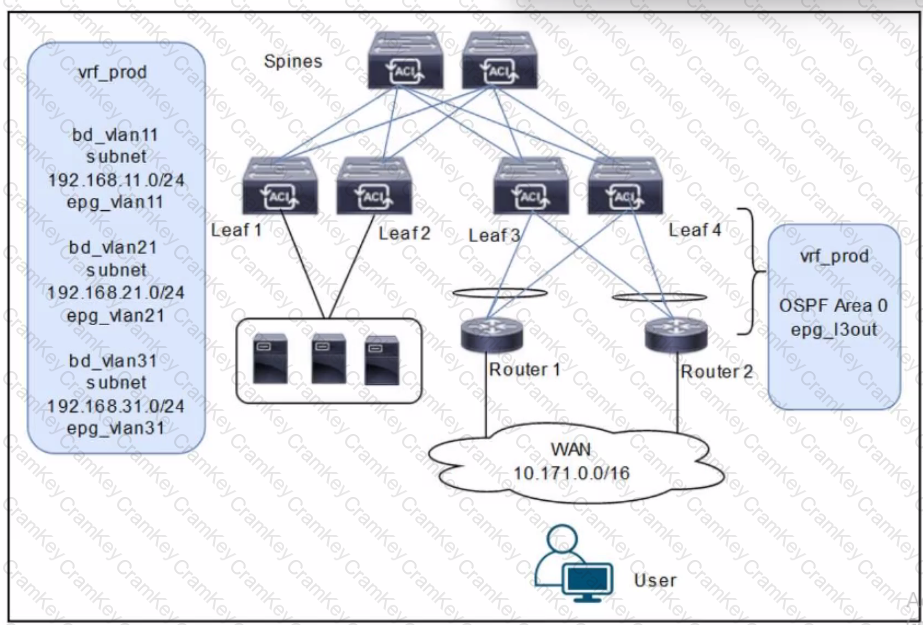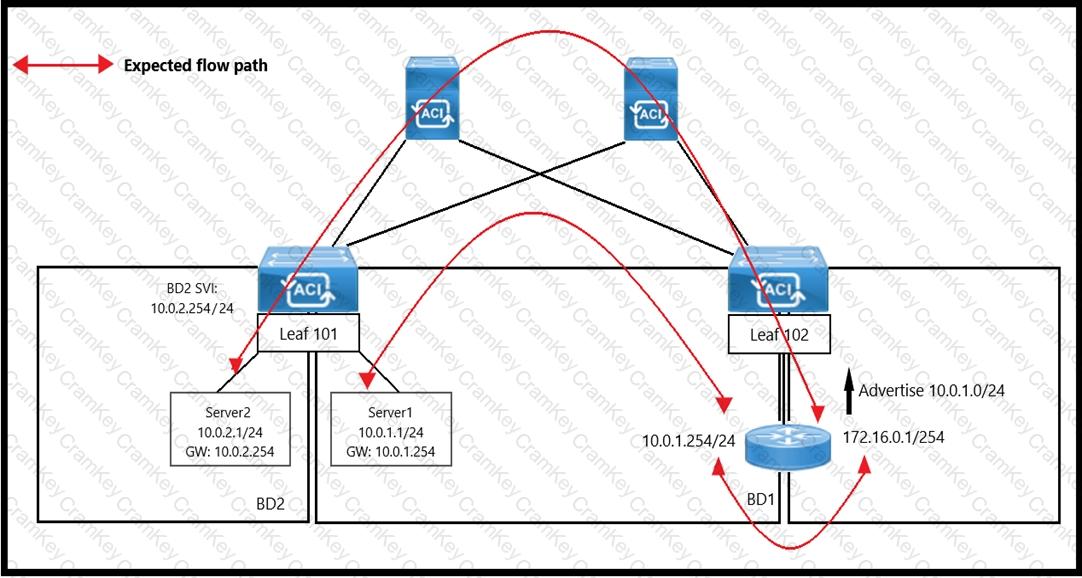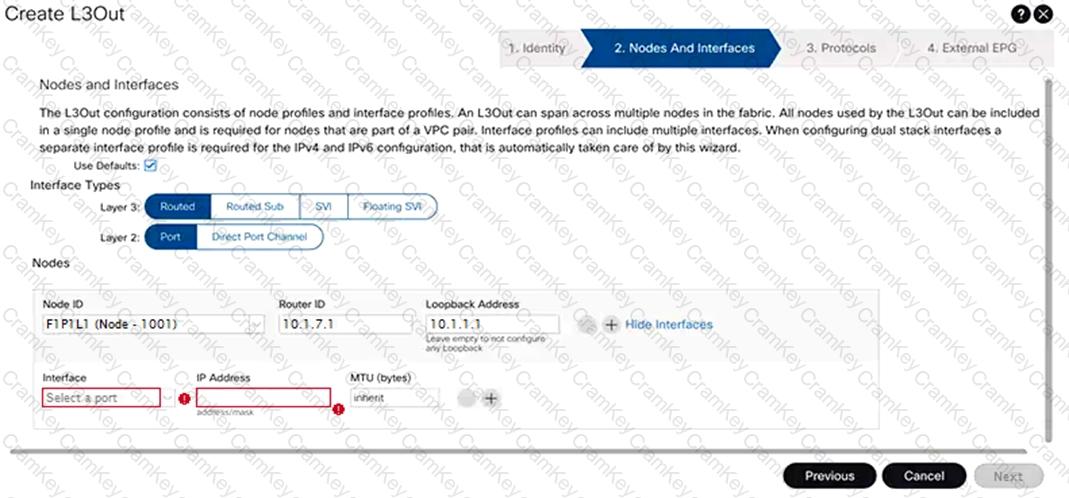The scenario involves deploying a WAN with Cisco ACI, where Routers 1 and 2 (connected via an L3Out with OSPF Area 0) must receive specific routes (192.168.11.0/24 and 192.168.21.0/24) from the ACI fabric, and reachability to WAN users must be permitted only for servers in vrf_prod. The diagram shows three bridge domains (bd_vlan11, bd_vlan21, bd_vlan31) with their respective subnets and EPGs, all under vrf_prod, along with an L3Out (epg_l3out) for WAN connectivity.
Requirement Analysis
Routers 1 and 2 must receive only routes 192.168.11.0/24 and 192.168.21.0/24:
These subnets belong to bd_vlan11 and bd_vlan21, respectively. To advertise these routes to Routers 1 and 2 via the L3Out, they must be marked with the appropriate scope in the bridge domain configuration.
In ACI, the "Advertised Externally" scope on a subnet ensures that it is advertised to external routers via the L3Out routing protocol (OSPF in this case).
Reachability to WAN users must be permitted only for servers in vrf_prod:
This implies that only the subnets in vrf_prod (192.168.11.0/24, 192.168.21.0/24, and 192.168.31.0/24) should be accessible, but WAN users should only reach specific subnets based on policy.
The external EPG (epg_l3out) represents the WAN users (10.171.0.0/16), and its subnet scope must control inbound reachability.
The subnet 192.168.31.0/24 (bd_vlan31) should not be advertised to the WAN, as it is not listed in the routes Routers 1 and 2 should receive.
Option Evaluation
A. Configure the subnets 192.168.11.0/24 and 192.168.21.0/24 as Private to VRF. Configure the subnet 192.168.31.0/24 as Advertised Externally. Configure an EPG subnet 0.0.0.0/0 as External Subnets for External EPG:
Setting 192.168.11.0/24 and 192.168.21.0/24 as "Private to VRF" means they are not advertised externally, which fails the requirement for Routers 1 and 2 to receive these routes.
Setting 192.168.31.0/24 as "Advertised Externally" incorrectly advertises this subnet to the WAN, which is not desired.
The "External Subnets for External EPG" scope on 0.0.0.0/0 allows WAN users to reach all subnets in vrf_prod, which is correct for reachability.
Conclusion: Fails the first requirement (route advertisement).
[: Cisco APIC Layer 3 Configuration Guide, "Subnet Scope Configuration.", B. Configure the subnets 192.168.11.0/24 and 192.168.21.0/24 as Private to VRF. Configure the subnet 192.168.31.0/24 as Advertised Externally. Configure an EPG subnet 0.0.0.0/0 as Shared Route Control Subnet: , Similar to Option A, setting 192.168.11.0/24 and 192.168.21.0/24 as "Private to VRF" prevents their advertisement to the WAN, failing the first requirement., Setting 192.168.31.0/24 as "Advertised Externally" incorrectly advertises this subnet., The "Shared Route Control Subnet" scope allows route leaking between VRFs, which is irrelevant here since there is only one VRF (vrf_prod) and no route leaking is required., Conclusion: Fails both requirements (route advertisement and reachability control)., Reference: Cisco ACI VRF Configuration Guide, "Route Leaking with Shared Subnets.", C. Configure the subnets 192.168.11.0/24 and 192.168.21.0/24 as Advertised Externally. Configure the subnet 192.168.31.0/24 as Private to VRF. Configure an EPG subnet 0.0.0.0/0 as Shared Route Control Subnet: , Setting 192.168.11.0/24 and 192.168.21.0/24 as "Advertised Externally" ensures these subnets are advertised to Routers 1 and 2 via OSPF, meeting the first requirement., Setting 192.168.31.0/24 as "Private to VRF" prevents its advertisement to the WAN, which aligns with the requirement since only 192.168.11.0/24 and 192.168.21.0/24 should be advertised., The "Shared Route Control Subnet" scope on 0.0.0.0/0 in the external EPG is incorrect for controlling reachability. This scope is used for route leaking, not for defining which subnets are accessible from the external EPG., Conclusion: Meets the first requirement but fails the second (reachability control)., Reference: Cisco ACI External EPG Configuration Guide, "Subnet Scopes.", D. Configure the subnets 192.168.11.0/24 and 192.168.21.0/24 as Advertised Externally. Configure the subnet 192.168.31.0/24 as Private to VRF. Configure an EPG subnet 0.0.0.0/0 as External Subnets for External EPG: , Setting 192.168.11.0/24 and 192.168.21.0/24 as "Advertised Externally" ensures these subnets are advertised to Routers 1 and 2 via OSPF, meeting the first requirement., Setting 192.168.31.0/24 as "Private to VRF" prevents its advertisement to the WAN, which is correct since only the specified subnets should be advertised., The "External Subnets for External EPG" scope on 0.0.0.0/0 in the external EPG (epg_l3out) allows WAN users (10.171.0.0/16) to reach all subnets in vrf_prod, which includes 192.168.11.0/24, 192.168.21.0/24, and 192.168.31.0/24. This satisfies the second requirement, as servers in vrf_prod are accessible, and contracts can further restrict access if needed (though not specified in the question)., Conclusion: Meets both requirements (route advertisement and reachability)., Reference: Cisco APIC Layer 3 Networking Configuration Guide, "L3Out Subnet Scopes" and "External EPG Configuration.", Final Answer Justification, D is correct because: , It ensures that only 192.168.11.0/24 and 192.168.21.0/24 are advertised to Routers 1 and 2 by setting their scope to "Advertised Externally.", It keeps 192.168.31.0/24 private to vrf_prod by setting its scope to "Private to VRF.", It allows WAN users to reach all vrf_prod subnets (including servers) by setting 0.0.0.0/0 as "External Subnets for External EPG," fulfilling the reachability requirement., Primary Cisco References: , Cisco APIC Layer 3 Configuration Guide, "Configuring Subnets for L3Out.", Cisco ACI Routing and Forwarding Guide, "External EPG and Subnet Scopes.", Cisco ACI Best Practices, "Controlling Route Advertisement and Reachability.", ]


